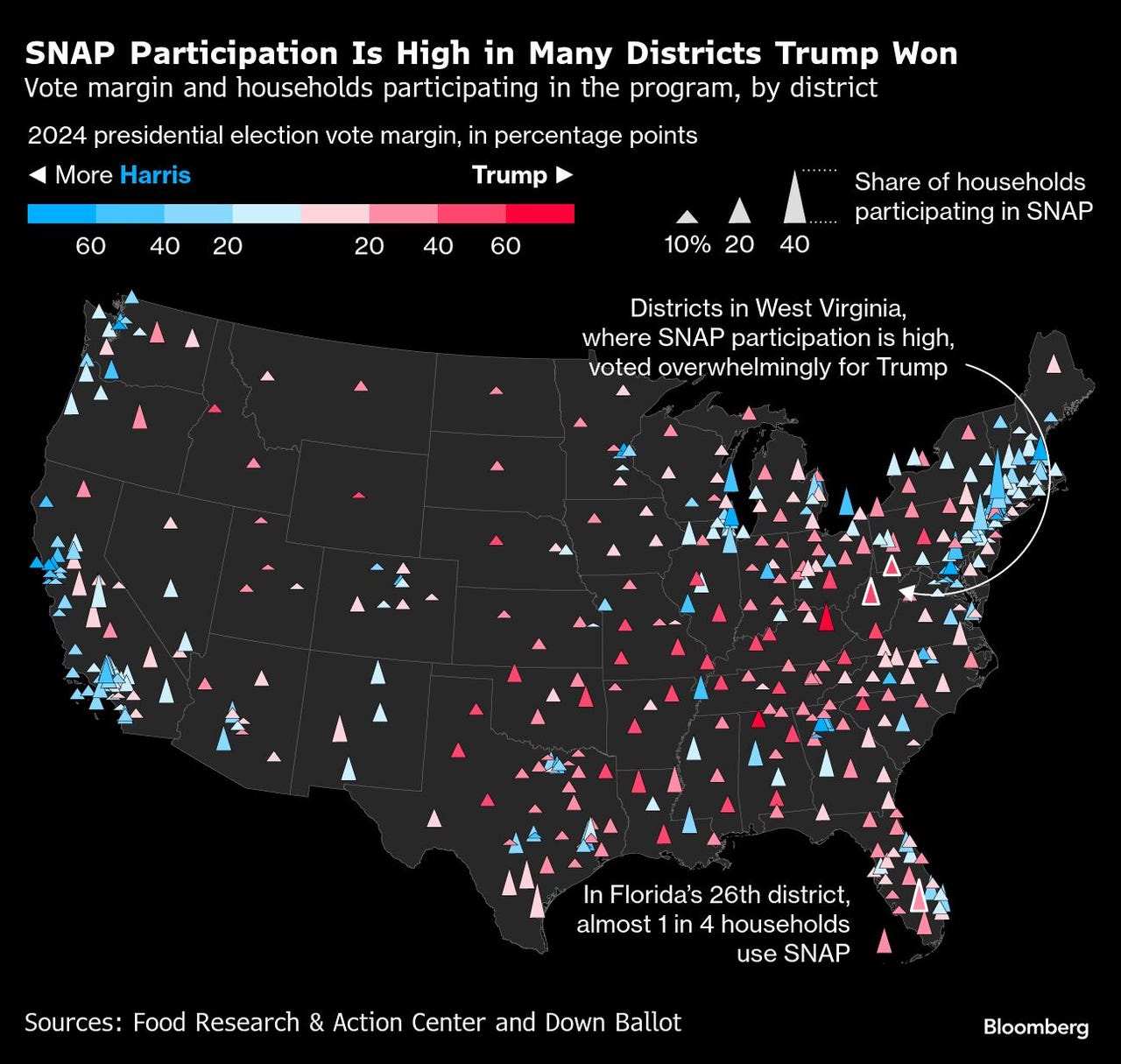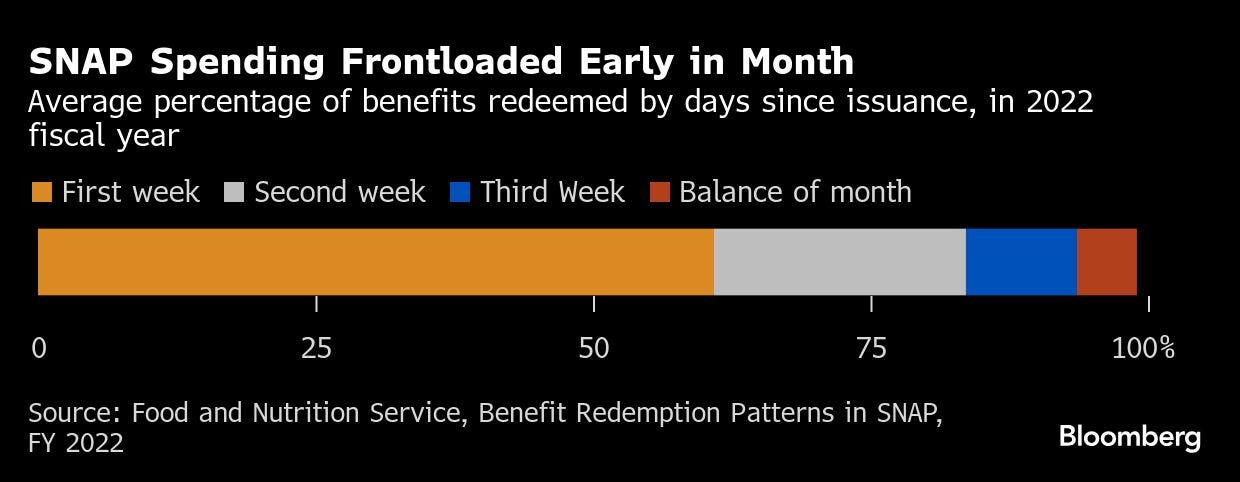By Kristina Peterson and Gregory Korte
About 42 million Americans could see their food assistance cut off within days as the U.S. government shutdown stretches toward its second month, threatening to deepen economic pain and test Washington’s resolve in one of the longest funding lapses in U.S. history.
The Supplemental Nutrition Assistance Program — better known as SNAP or food stamps — will run out of federal money Saturday if Congress doesn’t act. Food banks are bracing for surging demand and states are invoking emergency measures as lawmakers trade blame and debate whether to approve a narrow funding bill or reopen the entire government.
“You’re going to have real people, real families, you’re going to have children who will go hungry beginning this weekend when those resources dry up,” House Speaker Mike Johnson, a Louisiana Republican, told reporters Friday.
Democrats have said the Trump administration has the legal authority to continue funding food aid, but is choosing not to do so.
“They are illegally withholding food from 42 million Americans and it is shameful,” Representative Angie Craig of Minnesota, the top Democrat on the House Agriculture Committee, said Friday.

In West Virginia, Facing Hunger Foodbank is already getting triple the number of calls it usually receives — many from furloughed employees of local federal facilities, including prisons and Coast Guard operations, inquiring about food aid for the first time.
Chief Executive Officer Cyndi Kirkhart said her group had planned for 350 families at a mobile pantry stop this week. Eight hundred showed up. “Do we cut off at 350 and then turn everyone else away? Or do we really reduce the amount of food as we go through the line so that everyone gets something?” she said.
The Agriculture Department has told states to delay transmitting their November benefit files “until further notice,” effectively freezing the flow of food assistance until funding resumes. That directive was a reversal of its pre-shutdown contingency plan — since deleted from USDA’s website — that said the program can continue.
“Congressional intent is evident that SNAP’s operations should continue since the program has been provided with multi-year contingency funds,” the document dated Sept. 30 said. Agriculture Secretary Brooke Rollins told reporters Friday that the fund would not account for even half of the $9.2 billion needed to fund November SNAP benefits.
A coalition of 25 states has sued the Trump administration, saying officials are misreading federal law and sitting on contingency funds that Congress intended to keep the program running during lapses.
Wisconsin Governor Tony Evers warned that his state’s FoodShare program will run out of money in “days, not weeks,” leaving nearly 700,000 residents without aid. California has mobilized the National Guard to help food banks, while Colorado, Minnesota and Connecticut have authorized millions of dollars in emergency state funds to soften the blow.
It’s not just Democratic-led states: Republican Governor of Virginia Glenn Youngkin is tapping into rainy-day funds to weather the storm.
Food-stamp recipients are spread across both deep-blue and deep-red America, and places in between. Census data show that 13% of households in congressional districts that voted for Democrat Kamala Harris in 2024 had used SNAP the prior year. In Donald Trump-voting districts, it was 11%.
Most SNAP recipients use up their benefits early in the month, but some carry over balances they can spend later. USDA data show that in 2022, about 59% of recipients ended the month with less than $1 remaining.

Even if the shutdown ends soon, the restart of benefits won’t be immediate. States normally send electronic benefit transfer data files to their payment vendors by mid-month, and the systems can take several days to reload. California, for example, had to transmit its files by Oct. 23 to ensure benefits arrive by Nov. 1. And if every state sends its files at once, there could be logjams at major EBT contractors Conduent and Fidelity Information Services.
The looming cutoff is poised to ripple through the grocery industry, where SNAP benefits account for roughly 12% of U.S. food and beverage spending. Walmart Inc. captured more than a quarter of SNAP customers’ grocery dollars over the past year, according to Numerator. TD Cowen analyst Robert Moskow estimated that if SNAP households cut grocery purchases by 15%, total food sales could drop nearly 2%.
Mondelez International Inc. Chief Executive Dirk Van de Put told investors this week that the shutdown “will not help with the confidence of the consumer.” Kraft Heinz Co.’s Carlos Abrams-Rivera said “SNAP-related headwinds” are expected to intensify amid consumer sentiment he described as some of the worst in decades.
On Capitol Hill, the politics are hardening. Shutdowns usually end when the pain back home outweighs Congress’s appetite for a fight — but lawmakers still appear dug in despite the coming SNAP cutoff.
Senate Majority Leader John Thune called a Democratic plan to fund SNAP and the Women, Infants and Children nutrition program a “cynical attempt to buy political cover,” urging Democrats instead to accept a stopgap bill reopening the entire government.
“We’re not going to let them pick winners and losers,” Thune said. He also appeared lukewarm to an effort by Missouri Republican Senator Josh Hawley to fund SNAP through the shutdown.
Democrats note that presidents of both parties have found a way to continue SNAP benefits even without new funding.
“This is just pure, vicious hostage-taking,” Senate Minority Leader Chuck Schumer said, noting that food stamps continued during the 2019 shutdown in Trump’s first term. “Families are going to be in panic this weekend.”
Just five miles east of the U.S. Capitol, Gloria Butler is already planning how to stretch what she has. The 62-year-old Washington resident gets food stamps because of a disability and uses them to help feed her 7-year-old grandson.
“I just have to shop lightly,” she said, adding that she often buys chicken for him even though she’s vegan. “I definitely would feed my grandson first.”
The long-term impacts of the SNAP cutoff will be hard to measure. Last month, the USDA discontinued its annual Household Food Security Report — a key national survey that for decades tracked how many households struggled to get enough to eat.
In a statement, the department said the survey was “redundant, costly and politicized” and did “nothing more than fear monger.”
© 2025 Bloomberg L.P.